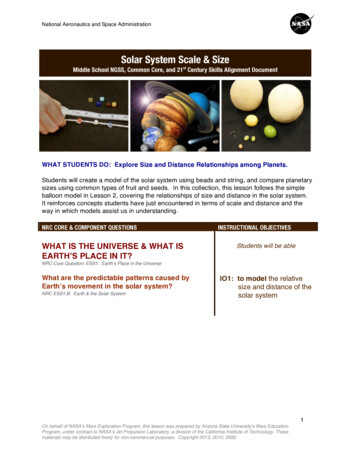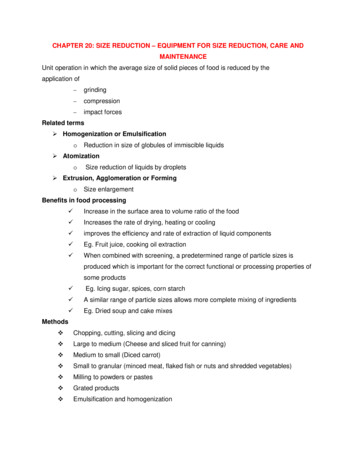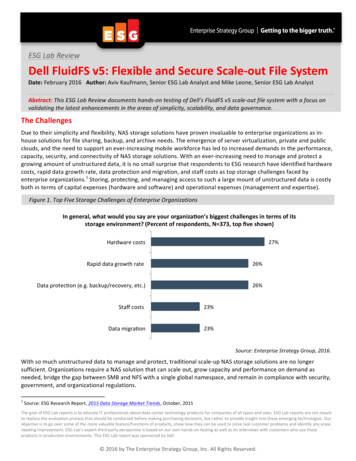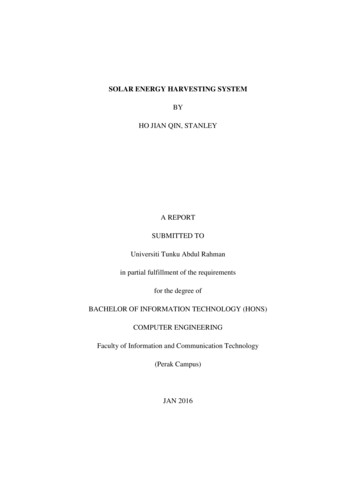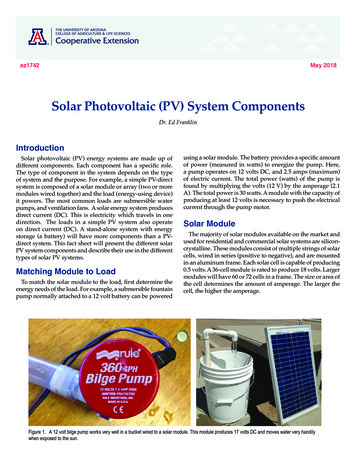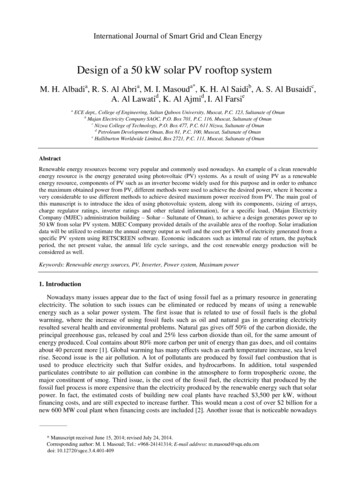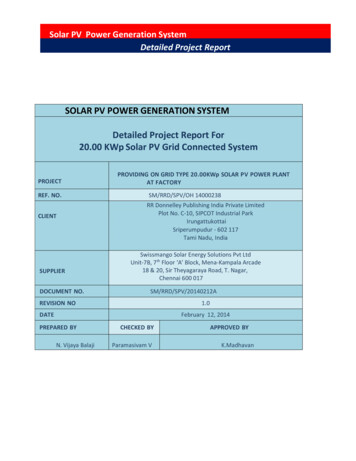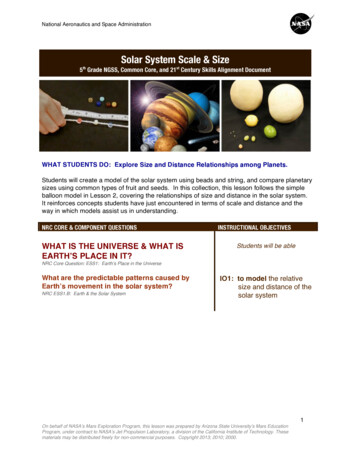
Transcription
National Aeronautics and Space AdministrationSolar System Scale & Size5th Grade NGSS, Common Core, and 21st Century Skills Alignment DocumentWHAT STUDENTS DO: Explore Size and Distance Relationships among Planets.Students will create a model of the solar system using beads and string, and compare planetarysizes using common types of fruit and seeds. In this collection, this lesson follows the simpleballoon model in Lesson 2, covering the relationships of size and distance in the solar system.It reinforces concepts students have just encountered in terms of scale and distance and theway in which models assist us in understanding.NRC CORE & COMPONENT QUESTIONSWHAT IS THE UNIVERSE & WHAT ISEARTH’S PLACE IN IT?INSTRUCTIONAL OBJECTIVESStudents will be ableNRC Core Question: ESS1: Earth’s Place in the UniverseWhat are the predictable patterns caused byEarth’s movement in the solar system?NRC ESS1.B: Earth & the Solar SystemIO1: to model the relativesize and distance of thesolar system1On behalf of NASA’s Mars Exploration Program, this lesson was prepared by Arizona State University’s Mars EducationProgram, under contract to NASA’s Jet Propulsion Laboratory, a division of the California Institute of Technology. Thesematerials may be distributed freely for non-commercial purposes. Copyright 2013; 2010; 2000.
National Aeronautics and Space Administration1.0 About This ActivityMars lessons leverage A Taxonomy for Learning, Teaching, and Assessing by Anderson andKrathwohl (2001) (see Section 4 and Teacher Guide at the end of this document). Thistaxonomy provides a framework to help organize and align learning objectives, activities, andassessments. The taxonomy has two dimensions. The first dimension, cognitive process,provides categories for classifying lesson objectives along a continuum, at increasingly higherlevels of thinking; these verbs allow educators to align their instructional objectives andassessments of learning outcomes to an appropriate level in the framework in order to build andsupport student cognitive processes. The second dimension, knowledge, allows educators toplace objectives along a scale from concrete to abstract. By employing Anderson andKrathwohl’s (2001) taxonomy, educators can better understand the construction of instructionalobjectives and learning outcomes in terms of the types of student knowledge and cognitiveprocesses they intend to support. All activities provide a mapping to this taxonomy in theTeacher Guide (at the end of this lesson), which carries additional educator resources.Combined with the aforementioned taxonomy, the lesson design also draws upon Miller, Linn,and Gronlund’s (2009) methods for (a) constructing a general, overarching, instructionalobjective with specific, supporting, and measurable learning outcomes that help assure theinstructional objective is met, and (b) appropriately assessing student performance in theintended learning-outcome areas through rubrics and other measures.How Students Learn: Science in the Classroom (Donovan & Bransford, 2005) advocates theuse of a research-based instructional model for improving students’ grasp of central scienceconcepts. Based on conceptual-change theory in science education, the 5E Instructional Model(BSCS, 2006) includes five steps for teaching and learning: Engage, Explore, Explain,Elaborate, and Evaluate. The Engage stage is used like a traditional warm-up to pique studentcuriosity, interest, and other motivation-related behaviors and to assess students’ priorknowledge. The Explore step allows students to deepen their understanding and challengesexisting preconceptions and misconceptions, offering alternative explanations that help themform new schemata. In Explain, students communicate what they have learned, illustratinginitial conceptual change. The Elaborate phase gives students the opportunity to apply theirnewfound knowledge to novel situations and supports the reinforcement of new schemata or itstransfer. Finally, the Evaluate stage serves as a time for students’ own formative assessment,as well as for educators’ diagnosis of areas of confusion and differentiation of further instruction.The 5E stages can be cyclical and iterative.2On behalf of NASA’s Mars Exploration Program, this lesson was prepared by Arizona State University’s Mars EducationProgram, under contract to NASA’s Jet Propulsion Laboratory, a division of the California Institute of Technology. Thesematerials may be distributed freely for non-commercial purposes. Copyright 2013; 2010; 2000.
National Aeronautics and Space Administration2.0 Instructional Objectives, Learning Outcomes, & StandardsInstructional objectives and learning outcomes are aligned with National Research Council’s, A Framework for K-12 Science Education: Practices,Crosscutting Concepts, and Core Ideas Achieve Inc.’s, Next Generation Science Standards (NGSS) National Governors Association Center for Best Practices (NGA Center) and Council ofChief State School Officers (CCSSO)’s, Common Core State Standards for EnglishLanguage Arts & Literacy in History/Social Studies, Science, and Technical Subjects Partnership for 21st Century Skills, A Framework for 21st Century LearningThe following chart provides details on alignment among the core and component NGSSquestions, instructional objectives, learning outcomes, and educational standards. Your instructional objectives (IO) for this lesson align with the NGSS Framework andNGSS. You will know that you have achieved these instructional objectives if studentsdemonstrate the related learning outcomes (LO). You will know the level to which your students have achieved the learning outcomes byusing the suggested rubrics (see Teacher Guide at the end of this lesson).Quick View of Standards Alignment:The Teacher Guide at the end of this lesson provides full details of standards alignment, rubrics,and the way in which instructional objectives, learning outcomes, 5E activity procedures, andassessments were derived through, and align with, Anderson and Krathwohl’s (2001) taxonomyof knowledge and cognitive process types. For convenience, a quick view follows:3On behalf of NASA’s Mars Exploration Program, this lesson was prepared by Arizona State University’s Mars EducationProgram, under contract to NASA’s Jet Propulsion Laboratory, a division of the California Institute of Technology. Thesematerials may be distributed freely for non-commercial purposes. Copyright 2013; 2010; 2000.
National Aeronautics and Space AdministrationWHAT IS THE UNIVERSE & WHAT IS EARTH’S PLACE IN IT?NRC Core Question: ESS1: Earth’s Place in the UniverseWhat are the predictable patterns caused by Earth’s movement in the solar system?NRC ESS1.B: Earth & the Solar SystemInstructional ObjectiveStudents will be ableIO1:to model therelative size anddistance of thesolar systemLearning OutcomesStudents will demonstrate themeasurable abilitiesLO1a. to compare therelative size anddistance of theplanets in the SolarSystemLO1b. to use a calculatedscale forestablishingrelative distancesLO1c. to predictcircumference anddistance using amodelLO1d. to explain scientificprocesses (scale,use of models)StandardsStudents will addressNSES: UNIFYING CONCEPTS &PROCESSES:K-12: (A1) Systems, order andorganizationK-12: (A2) Evidence, models, andexplanationsNGSS Practices:Developing and Using ModelsPlanning and Carrying outInvestigationsAnalyzing and Interpreting DataUsing Mathematics andComputational ThinkingScientific Knowledge is Based onEmpirical EvidenceScience Models, laws, Mechanisms,and theories Explain naturalPhenomenaNGSS Cross-Cutting Concept:Scale, Proportion and Quantity4On behalf of NASA’s Mars Exploration Program, this lesson was prepared by Arizona State University’s Mars EducationProgram, under contract to NASA’s Jet Propulsion Laboratory, a division of the California Institute of Technology. Thesematerials may be distributed freely for non-commercial purposes. Copyright 2013; 2010; 2000.
National Aeronautics and Space Administration3.0 Learning Outcomes, NGSS, Common Core, & 21st Century Skills ConnectionsThe connections diagram is used to organize the learning outcomes addressed in the lesson toestablish where each will meet the Next Generation Science Standards, ELA Common CoreStandards, and the 21st Century Skills and visually determine where there are overlaps in thesedocuments.Next GenerationScience StandardsCommon CoreLO1c: to predict circumferenceand distance using a modelLO1a: to compare the relative sizeand distance of the planets in theSolar SystemLO1b: to use a calculated scale forestablishing relative distancesLO1d. to explain scientificprocesses (scale, use of models)The Partnership forst21 Century Skills5On behalf of NASA’s Mars Exploration Program, this lesson was prepared by Arizona State University’s Mars EducationProgram, under contract to NASA’s Jet Propulsion Laboratory, a division of the California Institute of Technology. Thesematerials may be distributed freely for non-commercial purposes. Copyright 2013; 2010; 2000.
National Aeronautics and Space Administration4.0 Evaluation/AssessmentRubric: A rubric has been provided to assess student understanding of the simulation andto assess metacognition. A copy has been provided in the Student Guide for students toreference prior to the simulation. This rubric will allow them to understand the expectationsset before them.5.0 ReferencesAchieve, Inc. (2013). Next generation science standards. Achieve, Inc. on behalf of the twentysix states and partners that collaborated on the NGSS.Anderson, L.W., & Krathwohl (Eds.). (2001). A taxonomy for learning, teaching, and assessing:A revision of Bloom's taxonomy of educational objectives. New York: Longman.Bybee, R., Taylor, J., Gardner, A., Van Scotter, P., Carson Powell, J., Westbrook, A., Landes,N. (2006) The BSCS 5E instructional model: origins, effectiveness, and applications.Colorado Springs: BSCS.Donovan, S. & Bransford, J. D. (2005). How Students Learn: History, Mathematics, and Sciencein the Classroom. Washington, DC: The National Academies Press.Miller, Linn, & Gronlund. (2009). Measurement and assessment in teaching. Upper SaddleRiver, NJ: Pearson.National Academies Press. (1996, January 1). National science education standards. RetrievedFebruary 7, 2011 from http://www.nap.edu/catalog.php?record id 4962National Governors Association Center for Best Practices & Council of Chief State SchoolOfficers. (2010). Common Core State Standards. Washington, DC: Authors.National Research Council. (2012). A framework for K-12 science education: Practices,crosscutting concepts, and core ideas. Committee on a Conceptual Framework for NewK-12 Science Education Standards. Board on Science Education, Division of Behavioraland Social Sciences and Education. Washington, DC: The National Academies Press.The Partnership for 21st Century Skills (2011). A framework for 21st centurylearning. Retrieved March 15, 2012 from http://www.p21.org6On behalf of NASA’s Mars Exploration Program, this lesson was prepared by Arizona State University’s Mars EducationProgram, under contract to NASA’s Jet Propulsion Laboratory, a division of the California Institute of Technology. Thesematerials may be distributed freely for non-commercial purposes. Copyright 2013; 2010; 2000.
National Aeronautics and Space AdministrationSOLAR SYSTEM SIZE AND SCALETeacher Guide(L) Teacher Resource. Solar System Size and Scale Rubric (1 of 3)You will know the level to which your students have achieved the Learning Outcomes,and thus the Instructional Objective(s), by using the suggested Rubrics below.Instructional Objective 1: to model the relative size and distance of the solarsystemRelated Standard(s)National Science Education Standards (NSES)UNIFYING CONCEPTS & PROCESSESGrades K-12 (A1) Systems, Order, & Organization(Partial) The natural and designed world is complex; it is too large and complicated toinvestigate and comprehend all at once. Scientists and students learn to define small portionsfor the convenience of investigation. The units of investigation can be referred to as “systems.”A system is an organized group of related objects or components that form a whole. Systemscan consist, for example, of organisms, machines, fundamental particles, galaxies, ideas,numbers, transportation, and education . Prediction is the use of knowledge to identify andexplain observations or changes in advance. The use of mathematics, especially probability,allows for greater or lesser certainty of predictions .Grades K-12 (A2) Evidence, models, and explanationsEvidence consists of observations and data on which to base scientific explanations. Usingevidence to understand interactions allows individuals to predict changes in natural anddesigned systems. Models are tentative schemes or structures that correspond to real objects,events, or classes of events, and that have explanatory power. Models help scientists andengineers understand how things work. Models take many forms, including physical objects,plans, mental constructs, mathematical equations, and computer simulations.Scientific explanations incorporate existing scientific knowledge and new evidence fromobservations, experiments, or models into internally consistent, logical statements. Differentterms, such as “hypothesis,” “model,” “law,” “principle,” “theory,” and “paradigm” are used todescribe various types of scientific explanations.As students develop and as they understand more science concepts and processes, theirexplanations should become more sophisticated. That is, their scientific explanations shouldmore frequently include a rich scientific knowledge base, evidence of logic, higher levels ofanalysis, greater tolerance of criticism and uncertainty, and a clearer demonstration of therelationship between logic, evidence, and current knowledge.Next Generation Science Standards (NGSS)Practices: Developing and Using Models(Learning Outcomes Addressed: LO1a, LO1b, LO1c)7On behalf of NASA’s Mars Exploration Program, this lesson was prepared by Arizona State University’s Mars EducationProgram, under contract to NASA’s Jet Propulsion Laboratory, a division of the California Institute of Technology. Thesematerials may be distributed freely for non-commercial purposes. Copyright 2013; 2010; 2000.
National Aeronautics and Space Administration Develop and/or use models to describe and/or predict phenomena. (Grades 3-5)Develop a diagram or simple physical prototype to convey a proposed object, tool, orprocess. (Grades 3-5)Next Generation Science Standards (NGSS)Practices: Planning and Carrying out Investigations(Learning Outcomes Addressed: LO1a, LO1b, LO1c, LO1d) Evaluate appropriate methods and/or tools for collecting data. (Grades 3-5)Make observations and/or measurements to produce data to serve as the basis forevidence for an explanation of a phenomenon or test a design solution. (Grades 3-5)Next Generation Science Standards (NGSS)Practices: Analyzing and Interpreting Data(Learning Outcomes Addressed: LO1a, LO1b, LO1c, LO1d) Analyze and interpret data to make sense of phenomena, using logical reasoning,mathematics, and/or computation. (Grades 3-5)Compare and contrast data collected by different groups in order to discuss similaritiesand differences in their findings. (Grades 3-5)Next Generation Science Standards (NGSS)Practices: Using Mathematics and Computational Thinking(Learning Outcomes Addressed: LO1a, LO1b, LO1c) Describe, measure, estimate, and/or graph quantities (e.g., area, volume, weight, time)to address scientific and engineering questions and problems. (Grades 3-5)Next Generation Science Standards (NGSS)Practices: Scientific Knowledge is Based on Empirical Evidence(Learning Outcomes Addressed: LO1a, LO1b) Scientists use tools and technologies to make accurate measurements andobservations. (Grades 3-5)Next Generation Science Standards (NGSS)Cross-Cutting Concepts: Scale, Proportion and Quantity(Learning Outcomes Addressed: LO1a, LO1b, LO1c) Students recognize natural objects and observable phenomena exist from the very smallto the immensely large. They use standard units to measure and describe physicalquantities such as weight, time, temperature, and volume. (Grades 3-5)Common Core State StandardsSpeaking and Listening Standards: Comprehension and Collaboration(Learning Outcomes Addressed: LO1a, LO1c, LO1d)8On behalf of NASA’s Mars Exploration Program, this lesson was prepared by Arizona State University’s Mars EducationProgram, under contract to NASA’s Jet Propulsion Laboratory, a division of the California Institute of Technology. Thesematerials may be distributed freely for non-commercial purposes. Copyright 2013; 2010; 2000.
National Aeronautics and Space Administration Engage effectively in a range of collaborative discussions (one-on-one, in groups, andteacher-led) with diverse partners on grade 5 topics and texts, building on others’ ideasand expressing their own clearly.o Come to discussions prepared, having read or studied required material;explicitly draw on that preparation and other information known about the topic toexplore ideas under discussion.o Follow agreed-upon rules for discussions and carry out assigned roles.o Pose and respond to specific questions by making comments that contribute tothe discussion and elaborate on the remarks of others.o Review the key ideas expressed and draw conclusions in light of information andknowledge gained from the discussions.Common Core State StandardsMathematics – Numbers and Operations in Base Ten(Learning Outcomes Addressed: LO1b) 5.NBT.1 Recognize that in a multi-digit number, a digit in one place represents 10 timesas much as it represents in the place to its right and 1/10 of what it represents in theplace to its left.5.NBT.2 Explain patterns in the number of zeros of the product when multiplying anumber by powers of 10, and explain patterns in the placement of the decimal pointwhen a decimal is multiplied or divided by a power of 10. Use whole-number exponentsto denote powers of 10.5.NBT.3 Read, write, and compare decimals to thousandths.o Read and write decimals to thousandths using base-ten numerals, numbernames, and expanded form, e.g., 347.392 3 100 4 10 7 1 3 (1/10) 9 (1/100) 2 (1/1000).o Compare two decimals to thousandths based on meanings of the digits in eachplace, using , , and symbols to record the results of comparisons.5.NBT.4 Use place value understanding to round decimals to any place.5.NBT.5 Fluently multiply multi-digit whole numbers using the standard algorithm.5.NBT.6 Find whole-number quotients of whole numbers with up to four-digit dividendsand two-digit divisors, using strategies based on place value, the properties ofoperations, and/or the relationship between multiplication and division. Illustrate andexplain the calculation by using equations, rectangular arrays, and/or area models.21st Century SkillsCollaboration(Learning Outcomes Addressed: LO1a, LO1b, LO1d) Students work collaboratively with others, either virtually or face-to-face, whileparticipating in scientific discussions and appropriately using claims, evidence, andreasoning. (Grade 8 Benchmark)9On behalf of NASA’s Mars Exploration Program, this lesson was prepared by Arizona State University’s Mars EducationProgram, under contract to NASA’s Jet Propulsion Laboratory, a division of the California Institute of Technology. Thesematerials may be distributed freely for non-commercial purposes. Copyright 2013; 2010; 2000.
National Aeronautics and Space AdministrationTeacher GuideSOLAR SYSTEM SIZE AND SCALE(D) Teacher Resource. Solar System Size and Scale Rubric (2 of 2)Related Rubrics for the Assessment of Learning Outcomes Associated with the AboveStandard(s):Learning OutcomeLO1a: to comparethe relativesize anddistance of theplanets in theSolar SystemLO1b: to use acalculatedscale forestablishingrelativedistancesLO1c: to predictcircumferenceand distanceusing a modelLO1d: to explainscientificprocesses(scale, use ofmodels)ExpertModel is correctlyrefined from theprediction toreflect theappropriate sizeand distances ofthe bodies.ProficientModel is refinedfrom theprediction with aminimal amountof support fromthe facilitator.IntermediateModel is refinedfrom theprediction with afair amount ofsupport from thefacilitator.BeginnerModel reflects thepredicted modelfrom thebeginning of theactivity.Calculations areaccurate torelative scaledistances andsizes andappropriatemeasuring toolsare used.Calculations arerelativelyaccurate toscale distancesand sizes andappropriatemeasuring toolsare used.Calculations arerelativelyaccurate to scaledistances andsizes and mostmeasuring toolsare appropriate tothe task.Calculations aremade with avariety of tools.Prediction islogical and basedon evidence frompriorexaminations ofthe modelplanets.Predictions showinsightfulinterpretation ofthe data.Explanationdiscusses theuse of models asa predictive andexplanatory toolthat scientistsuse totest/communicatescientificphenomena.Prediction islogical andbased onevidence frompriorexaminations ofthe modelplanets.Prediction islogical and usessome evidencefrom priorexaminations ofmodel planets.Prediction iswritten and basedon personalpreferences.Explanationdiscusses theuse of modelsas a predictiveor explanatorytool thatscientists use totest ses theuse of models asan explanatorytool thatscientists use ses use ofmodels byscientists.10On behalf of NASA’s Mars Exploration Program, this lesson was prepared by Arizona State University’s Mars EducationProgram, under contract to NASA’s Jet Propulsion Laboratory, a division of the California Institute of Technology. Thesematerials may be distributed freely for non-commercial purposes. Copyright 2013; 2010; 2000.
National Aeronautics and Space AdministrationTeacher GuideSOLAR SYSTEM SIZE AND SCALE(L) Teacher Resource. Solar System Size and Scale Rubric (2 of 3)Partnership for 21st Century SkillsEffectiveness ofcollaboration with teammembers and yInterested incollaborating in thesimulation. Activelyprovides solutionsto problems, listensto suggestions fromothers, attempts torefine them,monitors groupprogress, andattempts to ensureeveryone has acontribution.ExtremelyInterested incollaborating in thesimulation. Activelyprovidessuggestions andoccasionally listensto suggestions fromothers. Refinessuggestions fromothers.Interested incollaborating in thesimulation. Listensto suggestions frompeers and attemptsto use them.Occasionallyprovidessuggestions ingroup discussion.Interested incollaborating in thesimulation.11On behalf of NASA’s Mars Exploration Program, this lesson was prepared by Arizona State University’s Mars EducationProgram, under contract to NASA’s Jet Propulsion Laboratory, a division of the California Institute of Technology. Thesematerials may be distributed freely for non-commercial purposes. Copyright 2013; 2010; 2000.
National Aeronautics and Space AdministrationTeacher GuideSOLAR SYSTEM SIZE AND SCALE(L) Teacher Resource. Solar System Size and Scale Rubric (3 of 3)Common Core – ELAEffective Demonstration ofComprehension erClearly articulatesideas incollaborativediscussion whilefollowing agreedupon class rules fordiscussion.Extremely prepareddrawing fromexperiences. Asksclarifying questionsto ensure fullunderstanding ofcontent. Articulatesown ideas related tothe discussion andconnects othersideas to own.Articulates ideas incollaborativediscussion whilefollowing agreedupon class rules fordiscussion.Prepared fordiscussion bydrawing fromexperiences. Asksquestions.Articulates ownideas related to thediscussion.Interested incollaborativediscussion. Asksquestions.Articulates ownideas related tothe discussion.Interested incollaboration withpeers.12On behalf of NASA’s Mars Exploration Program, this lesson was prepared by Arizona State University’s Mars EducationProgram, under contract to NASA’s Jet Propulsion Laboratory, a division of the California Institute of Technology. Thesematerials may be distributed freely for non-commercial purposes. Copyright 2013; 2010; 2000.
National Aeronautics and Space AdministrationSOLAR SYSTEM SIZE AND SCALETeacher Guide(M) Teacher Resource. Placement of Instructional Objective and Learning Outcomes inTaxonomy (1 of 3)This lesson adapts Anderson andKrathwohl’s (2001) taxonomy,which has two domains:Knowledge and CognitiveProcess, each with types andsubtypes (listed below). Verbs forobjectives and outcomes in thislesson align with the suggestedknowledge and cognitive processarea and are mapped on the nextpage(s). Activity procedures andassessments are designed tosupport the targetknowledge/cognitive process.KnowledgeA. FactualAa: Knowledge of TerminologyAb: Knowledge of Specific Details &ElementsB. ConceptualBa: Knowledge of classifications andcategoriesBb: Knowledge of principles andgeneralizationsBc: Knowledge of theories, models, andstructuresC. ProceduralCa: Knowledge of subject-specific skillsand algorithmsCb: Knowledge of subject-specifictechniques and methodsCc: Knowledge of criteria for determiningwhen to use appropriate proceduresD. MetacognitiveDa: Strategic KnowledgeDb: Knowledge about cognitive tasks,including appropriate contextual andconditional knowledgeDc: Self-knowledgeCognitive Process1. Remember1.1Recognizing (Identifying)1.2Recalling (Retrieving)2. Understand2.1Interpreting (Clarifying, Paraphrasing,Representing, Translating)2.2Exemplifying (Illustrating, Instantiating)2.3Classifying (Categorizing, Subsuming)2.4Summarizing (Abstracting, Generalizing)2.5Inferring (Concluding, Extrapolating,Interpolating, Predicting)2.6Comparing (Contrasting, Mapping, Matching2.7Explaining (Constructing models)3. Apply3.1Executing (Carrying out)3.2Implementing (Using)4. Analyze4.1Differentiating (Discriminating, distinguishing,focusing, selecting)4.2Organizing (Finding coherence, integrating,outlining, parsing, structuring)4.3Attributing (Deconstructing)5. Evaluate5.1Checking (Coordinating, Detecting,Monitoring, Testing)5.2Critiquing (Judging)6. Create6.1Generating (Hypothesizing)6.2Planning (Designing)6.3Producing (Constructing)13On behalf of NASA’s Mars Exploration Program, this lesson was prepared by Arizona State University’s Mars EducationProgram, under contract to NASA’s Jet Propulsion Laboratory, a division of the California Institute of Technology. Thesematerials may be distributed freely for non-commercial purposes. Copyright 2013; 2010; 2000.
National Aeronautics and Space AdministrationTeacher GuideSOLAR SYSTEM SIZE AND SCALE(M) Teacher Resource. Placement of Instructional Objective and Learning Outcomes inTaxonomy (2 of 3)IO1: to model the relative size and distance of the solar system (6.3; Bc)LO1a. to compare the relative size and distance of the planets in the Solar System (2.6; Bc)LO1b. to use a calculated scale for establishing relative distances (3.1; Ca)LO1c. to predict circumference and distance using a model (6.1; Bb)LO1d to explain scientific processes (scale, use of models) (2.7; Da)IO 1LO1cLO1dLO1bLO1a14On behalf of NASA’s Mars Exploration Program, this lesson was prepared by Arizona State University’s Mars EducationProgram, under contract to NASA’s Jet Propulsion Laboratory, a division of the California Institute of Technology. Thesematerials may be distributed freely for non-commercial purposes. Copyright 2013; 2010; 2000.
National Aeronautics and Space AdministrationSOLAR SYSTEM SIZE AND SCALETeacher Guide(M) Teacher Resource. Placement of Instructional Objective and Learning Outcomes inTaxonomy (3 of 3)The design of this activity leverages Anderson & Krathwohl’s (2001) taxonomy as a framework.Below are the knowledge and cognitive process types students are intended to acquire per theinstructional objective(s) and learning outcomes written for this lesson. The specific, scaffolded5E steps in this lesson (see 5.0 Procedures) and the formative assessments (worksheets in theStudent Guide and rubrics in the Teacher Guide) are written to support those objective(s) andlearning outcomes. Refer to (M, 1 of 3) for the full list of categories in the taxonomy from whichthe following were selected. The prior page (M, 2 of 3) provides a visual description of theplacement of learning outcomes that enable the overall instructional objective(s) to be met.At the end of the lesson, students will be ableIO1: to construct a simple model6.3: to constructBc: knowledge of theories, models, and structuresTo meet that instructional objective, students will demonstrate the abilities:LO1a: to compare size/distance in model2.6: to compareBc: knowledge of theories, models, and structuresLO1b: to use a calculated scale for establishing relative distances3.1: to useCa: knowledge of subject-specific skills and algorithmsLO1c: to predict using a model6.1: to predictBb: knowledge of principles and generalizationsLO1d: to explain scientific processes2.7: to explainDa: strategic knowledge15On behalf of NASA’s Mars Exploration Program, this lesson was prepared by Arizona State University’s Mars EducationProgram, under contract to NASA’s Jet Propulsion Laboratory, a division of the California Institute of Technology. Thesematerials may be distributed freely for non-commercial purposes. Copyright 2013; 2010; 2000.
Mars lessons leverage A Taxonomy for Learning, Teaching, and Assessing by Anderson and Krathwohl (2001) (see Section 4 and Teacher Guide at the end of this document). This taxonomy provides a framework to help organize and align learning objectives, activities, and assessments. The taxonomy
